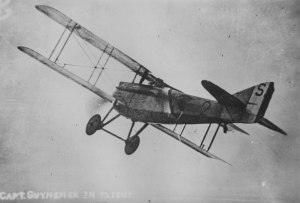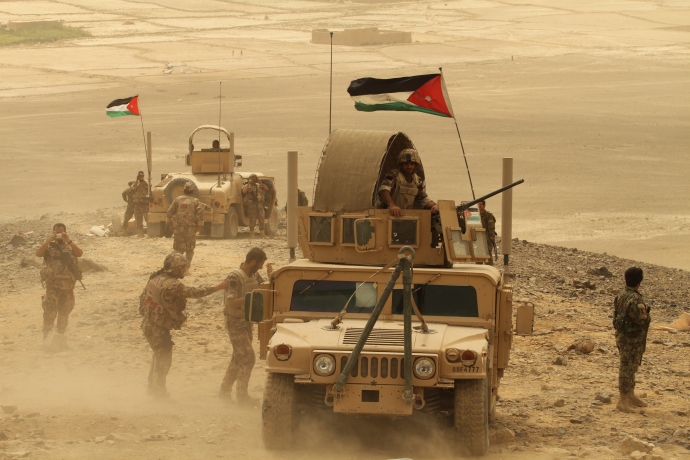
Aerial view of Verdun, 1916.
In February 1916, the German Army unleashed a surprise offensive against the French defenders in the Verdun sector of the Western Front. Verdun was one of the fortress cities built by the French after the 1871 war. In the rolling hills around the town, a series of reinforced concrete and underground forts had been built. Heavily protected, extremely well armed with such innovations as retracting gun turrets, the Verdun forts were supposed to break up any German offensive, or at least stall it long enough for the army to counter-attack.

French military aviation came of age at Verdun, and the fighting there produced such fighter legends as Jean Navarre and Charles Guynemer.
But after the Germans took out the Belgian forts at Liege so quickly in 1914, the French Army assumed the day of the massive concrete fort had come and gone. Now, thanks to modern heavy artillery, almost any defensive structure could be pummeled to ruins before any troops had to be sent in to occupy it. As a result of that conclusion, the French stripped the forts around Verdun, sending the garrisons and much of the artillery into the front lines elsewhere on the Western Front.
Nevertheless, the forts remained a source of considerable national pride, something that the Germans were counting on that February. The idea behind the German offensive was not necessarily to capture ground, but rather to force the French Army to defend a region considered vital to France’s national morale. If the vaunted impregnable fortress Verdun could fall, how could the Germans be stopped? So, the Germans counted on the French throwing everything they could spare into the defense of Verdun, and when they did, they would bleed the Gaulic army white with massed artillery bombardments, gas attacks and limited infantry assaults, heavily supported by machine guns and the new flamethrowers just arriving in the front line German units.
That was the rational anyway.
The German offensive began with one of the most intense artillery barrages in human history. The French front lines were almost totally destroyed by the shelling, and the initial waves of German infantry pushed deep into French territory. But as the French Army reacted and threw in reinforcements, the lines gradually hardened again. Repeated French counter-attacks slowed the Germans, but came at such a cost that some divisions lasted only a few days in the battle before they had to be pulled out and reformed. Losses ran over sixty percent in those units, and in others, entire companies were swallowed up in the inferno.

The Morte Homme, a small hill and ridge that was the scene of heavy fighting, became one of the symbolic points of French resistance at Verdun.
The Germans scored a huge propaganda victory when a small group of their soldiers captured the most modern of the Verdun Forts, Douaumont, by a coup de main. The truth was, there was only a tiny French garrison left inside the fort, and once the Germans found a way inside, the place was doomed to fall. But, lesson learned. After that, the French Army resupplied and reinforced the remaining forts.
The offensive continued with both sides throwing fresh troops into the fray. The battle became less about the ground and more about the spirit and resolve of each nation. Both sides and staked their prestige and national pride on the outcome, though ultimately Verdun had much more importance in the French psyche than the German. Ultimately, an offensive designed with one objective: kill as many French soldiers as possible, became a test of national will.
The French committed an entire generation of its young men to the defense of Verdun. Well over half of the French Army passed through the salient during the 1916 campaign, and more than any other WWI battle, it left an indelible mark on France’s soldiers. They fought in mud and water-filled trenches and shell craters, living among the rotting remains of the dead. Scavengers–birds, rats, feral dogs–fed off those remains in No Man’s Land, and veterans later wrote how the corpses splayed between the lines would sometimes twitch and jerk as animals ate them from the inside out.

Battered Douaumont.
The medical logistical system never kept pace with the flow of wounded. Men writhed for hours, sometimes days unattended where they fell as they waited for stretcher bearers to come relieve their suffering. But even then, they faced hours of travel to the nearest aid station, where the wounded were laid out often without protection from the elements as overwhelmed surgeons did what they could. Gas gangrene, infection, pneumonia and shock claimed countless victims. Those who survived were scarred forever by the sights, smells and sounds of those facilities.
As Verdun became a carnival of horrors, the vitality of the French Army was pulverized in its killing grounds. And yet, the French troops continued to fight with near suicidal determination. In July, 1916, the Germans surrounded Fort Vaux, one of the last of the remaining fixed emplacements defending Verdun. For a week, Fort Vaux’s defenders held out against staggering odds. They fought the Germans corridor to corridor in darkened, underground passageways. The Germans used gas, bayonets and grenades to clear the fort gallery by gallery. The dead stacked up, and the French survivors took to drinking their own urine to slake their thirst after the Germans captured Vaux’s water supply. When the fort’s commander, Colonel Raynal, finally surrendered his battered force after a week of furious fighting, the Germans were so taken by his stout defense that they allowed him to carry his sword into captivity.

Aerial view of Fort Vaux and the thousands of shell craters that pockmarked the terrain around it.
By late summer, the German offensives had played out, and they could not devote anymore troops to the Verdun Sector as a result of the British offensive along the Somme River. The French mustered their reserves and wrested the initiative from the Germans with a series of bold attacks that recaptured almost all the ground lost earlier in the year. The French had won the Battle of Verdun, but it had cost them the soul of a generation. Men, no matter how motivated, well-trained and patriotic, will always have a breaking point, and the brutal losses and psychological trauma of Verdun pushed the French Army to the breaking point. After a failed offensive in April 1917, much of the French Army mutinied in their trenches. Order was restored by June, thanks to Marshal Petain, but the French Army would never be the same again.
To understand the French Army of World War II, Indo-China and Algeria, one first has to understand the impact Verdun had on the nation and its fighting men. They’d saved the Republic, but mortgaged the future to do it. And the land around Verdun reflected the damage done to the nation. Endless fields of shell craters, one atop the other, still bear silent testimony to the ferocity of the artillery bombardments. The shelling destroyed much of the top soil, and for years little would grow on those battlefields. It took a national reforestation program to change that.
Farmers still encounter human remains. Some are taken to the Ossuary at Verdun, where visitors can see through glass windows the bones of thousands of unknown soldiers–French, German and (later in 1918) American. I was there in 1984 and peered in through the glass. The sight changed my own life forever.
Something like 550,000 French Soldiers are known to have been killed or wounded, or went missing during the Battle of Verdun. The Germans lost at least 430,000. About eight million French males served in the army between 1914-18. Of those, almost 1.4 million were killed, and 4.2 million wounded severely. It has been estimated that 90% of all French men between the ages of 18 and 24 either died during the war, or came home with debilitating physical wounds.
A generation lost to the defense of a nation. America has never known such a complete and devastating sacrifice. Here is to hoping we never will.
If you read one book about World War I, read Alistar Horne’s treatment of Verdun called, The Price of Glory. It is one of the great works of military history. Find it here:
http://www.amazon.com/Price-Glory-Verdun-1916/dp/0140170413/ref=sr_1_2?ie=UTF8&qid=1421699895&sr=8-2&keywords=verdun


 This week, Bloomberg News reported that the new Secretary General of NATO, Jens Stoltenberg, was in Washington D.C. for meetings and asked the White House for some time with the President while he was here. According to reports, the White House staff did not even respond. This broke with a long standing tradition that when the Secretary General of NATO was in D.C., the President always made time to see him. Full article is here: http://www.bloombergview.com/articles/2015-03-24/obama-snubs-nato-chief-as-crisis-rages.
This week, Bloomberg News reported that the new Secretary General of NATO, Jens Stoltenberg, was in Washington D.C. for meetings and asked the White House for some time with the President while he was here. According to reports, the White House staff did not even respond. This broke with a long standing tradition that when the Secretary General of NATO was in D.C., the President always made time to see him. Full article is here: http://www.bloombergview.com/articles/2015-03-24/obama-snubs-nato-chief-as-crisis-rages.



 Despite the German invasion and the Luftwaffe’s depredations, the fleet survived virtually intact. When King Haakon reached London, he delivered the 4.8 million ton Norwegian merchant marine to the Allied cause. This was manna from heaven for Great Britain, whose survival soon depended on these ships. By 1942, forty percent of Britain’s oil rode to the Home Islands aboard Norwegian tankers. Without their contribution, England would surely have been doomed, but the Norwegian crews never received credit for this crucial component to the Allied victory.
Despite the German invasion and the Luftwaffe’s depredations, the fleet survived virtually intact. When King Haakon reached London, he delivered the 4.8 million ton Norwegian merchant marine to the Allied cause. This was manna from heaven for Great Britain, whose survival soon depended on these ships. By 1942, forty percent of Britain’s oil rode to the Home Islands aboard Norwegian tankers. Without their contribution, England would surely have been doomed, but the Norwegian crews never received credit for this crucial component to the Allied victory.


























